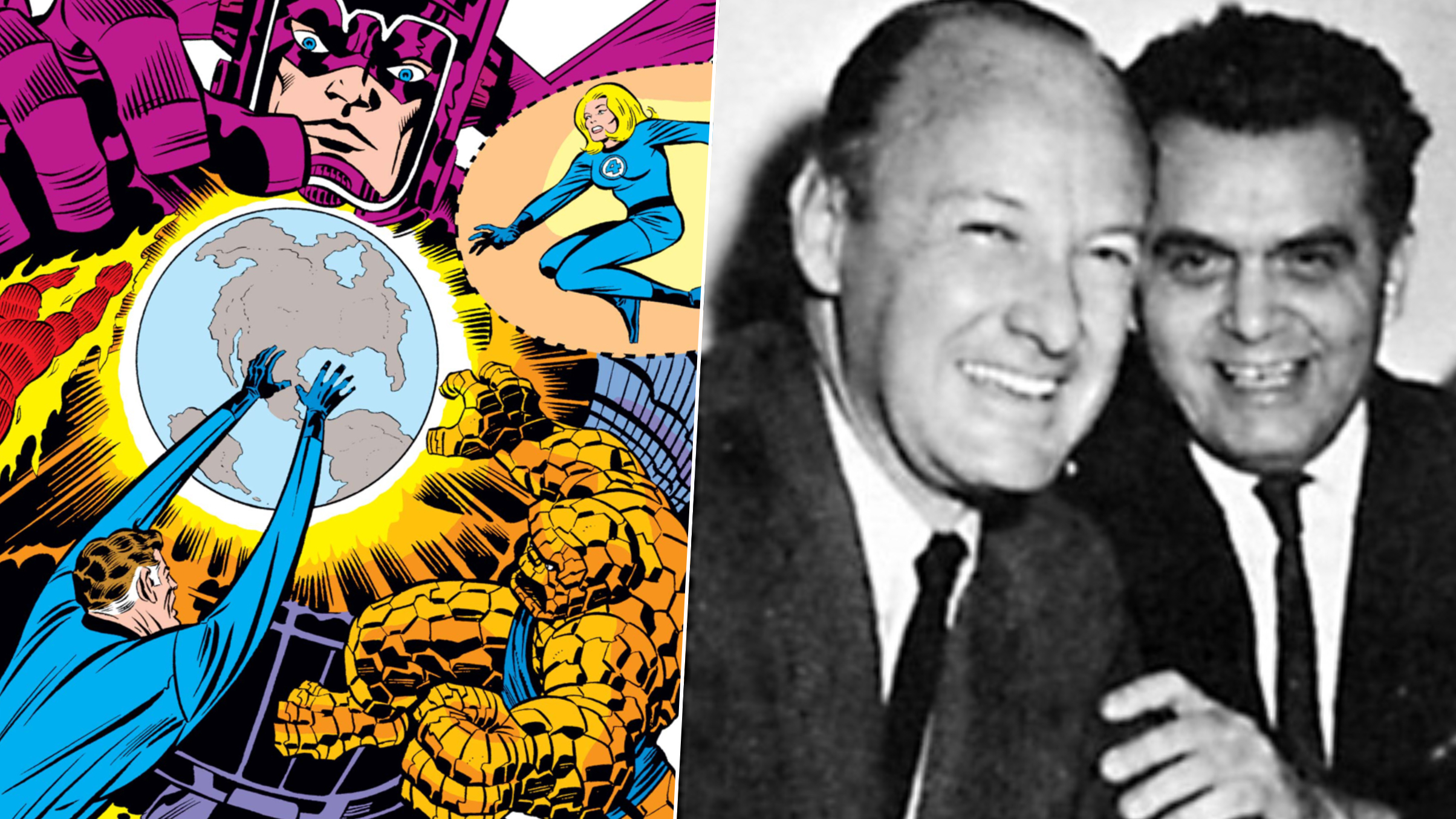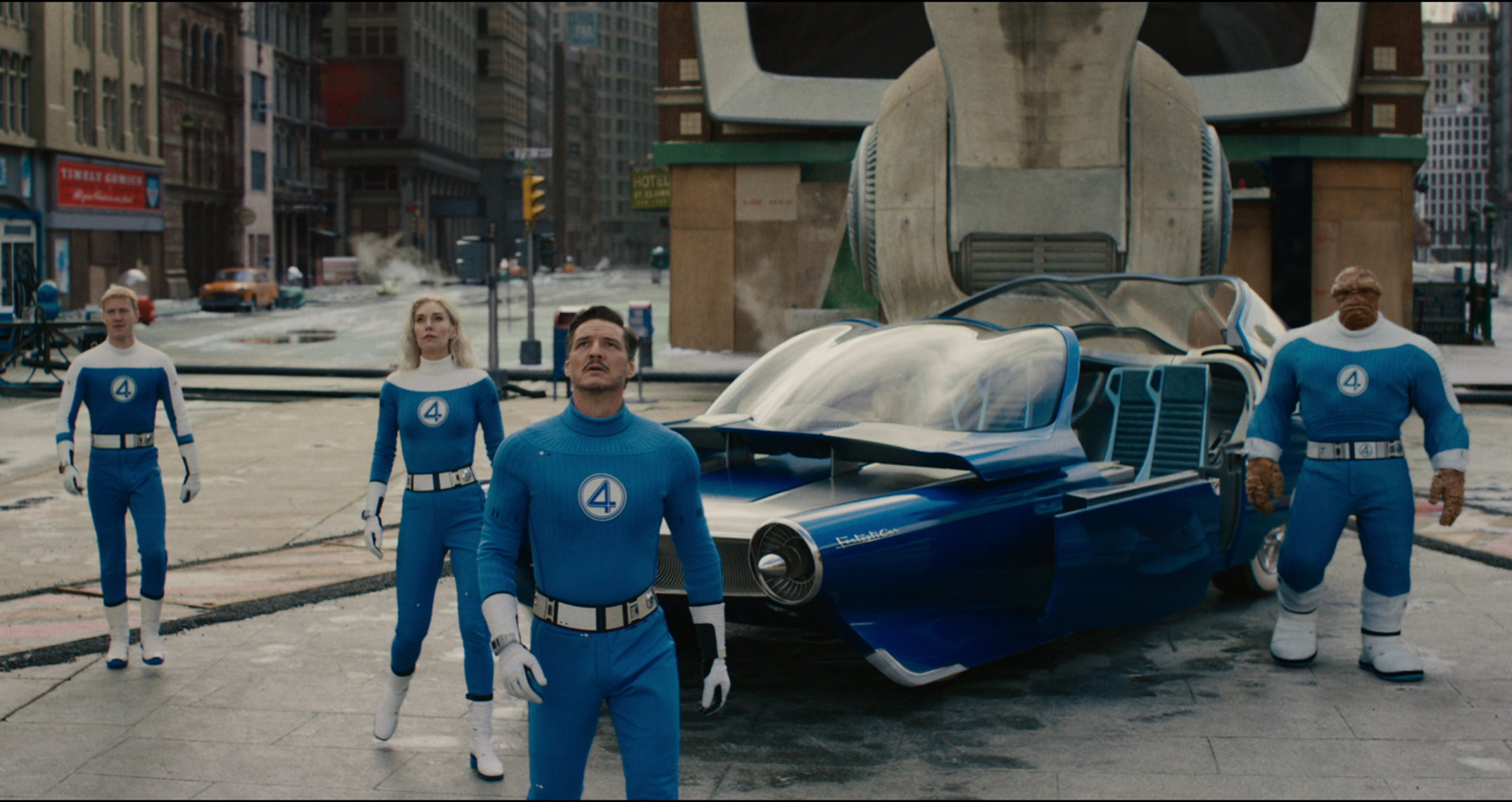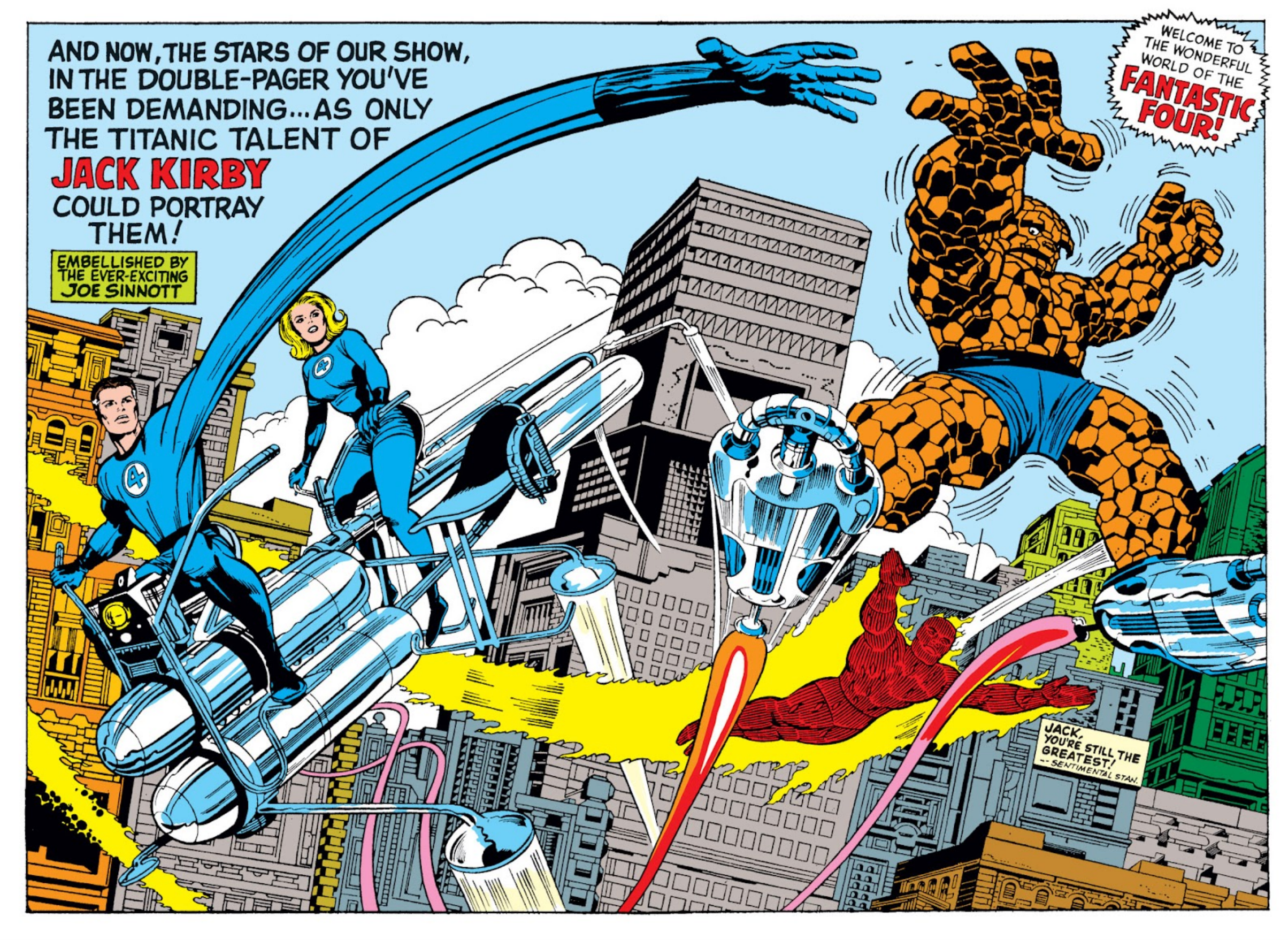
In a Marvel-esque homage to the late creators Stan Lee and Jack Kirby, the film “Fantastic Four: First Steps” is beautifully set. It’s established in a 1960s-inspired world, known as Earth 828, named after Kirby’s birthday (August 28). The story unfolds in a universe where Marvel’s original superhero family – Reed Richards (Pedro Pascal), Sue Storm (Vanessa Kirby), Johnny Storm (Joseph Quinn), and Ben Grimm (Ebon Moss-Bachrach) – have achieved celebrity status. They are featured on magazines like Time, cereal boxes, their own cartoon series titled “The Fantastic Four Power Hour,” and even an authorized comic book by the Future Foundation.
The first appearance of Silver Surfer (Julia Garner) amidst flaming skies, signaling Galactus’ (Ralph Ineson) arrival in New York City’s Times Square, takes place near Timely Comics offices. Two employees from Timely Comics, resembling the pioneers Kirby and Lee of the early ’60s (represented by Martin Dickinson and Greg Haiste), are awestruck by the radiant figure riding a surfboard. These employees mirror the appearances of Kirby and Lee before Stan “The Man” Lee became Marvel’s public face, reflecting Haiste’s accurate portrayal of that era.

Timely Comics marked the beginning from which Marvel Comics later emerged, with Stan Lee and Jack Kirby introducing the contemporary Marvel Universe through the first issue of The Fantastic Four in August 1961. In their initial comic book, the Fantastic Four – Mister Fantastic, the Invisible Woman, the Human Torch, and the Thing – encountered the danger posed by the Mole Man and his underground horde of monstrous creatures, including Giganto who was defeated by the Thing in a series of scenes reminiscent of the film’s iconic cover.

The office of Timely (now Marvel) is filled with hidden tributes called Easter eggs, one of which seems to be inspired by the 1960s issue #79 of Strange Tales comic book. This particular comic was jointly written by Lee and illustrated by Don Heck, who would later become a collaborator in creating Iron Man. The cover for this issue featuring monsters was originally done by Jack Kirby, and the monster portrayed within is none other than “The Thing.

On the wall, you’ll find two pieces from the creative partnership between Lee and Kirby. One is an uncolored page from the 1961 issue of “Tales of Suspense” #27, a story called “Oog Lives Again!” The other is a fully-colored artwork from 1963’s “Fantastic Four” #13, which marked the debut of the Red Ghost and Uatu the Watcher. This specific page comes from the third part of the issue, titled “The Watcher Appears.” Although Uatu isn’t present in this exhibit (First Steps), he played a significant role in the original “Galactus Trilogy” by Lee and Kirby in “Fantastic Four” issues #48-50. These comics served as inspiration for the film.

Kirby and Lee worked together on over a hundred issues of Fantastic Four from 1961 to 1971. During their celebrated period, they occasionally inserted themselves into the story, breaking the fourth wall: Doctor Doom appeared at the Marvel editorial office in Fantastic Four #10 from 1962, and “Jack and Stan” were notoriously denied entry at Reed and Sue’s wedding in the multiple-cameo Annual #3 of Fantastic Four in 1965.

In my perspective, I’m a testament to Jack Kirby’s visionary nature. As I stand here today, Marvel Studios might not exist without him. He was the mastermind behind countless iconic characters and the architect of this vast universe he co-created with Stan Lee. Many of our beloved heroes were born from his mind and brought to life by his pen. Our aim is to pay tribute to that genius, to honor his unique style.
The filmmakers referred to this style as “a fusion of Kirby and Kubrick,” as it combined elements reminiscent of the visionary writer-director who created the groundbreaking sci-fi film, 2001: A Space Odyssey, in 1968. (Notably, this style was first seen in a 1976 Marvel Treasury Special, marking the first instance of “Kirby meeting Kubrick.”)
Kevin Feige, Marvel Studios president and producer, expressed that they aimed for something more significant than a casual acknowledgment. He explained that there are direct connections from Jack Kirby’s original drawings, which he created all by himself and filled with his vast, universe-wide imagination, to this movie. Feige further stated that Kirby, the co-creator of characters like Captain America, Hulk, Thor, Black Panther, X-Men, and Avengers, was a remarkable storyteller and artist of the 20th century.

Feige expressed that the intention behind this film was to wholeheartedly honor Mr. Kirby, a creative genius who deserves equal recognition alongside Stan Lee in all discussions. He may not have been as vocal or prominent as Lee, but his impact remains significant. Unfortunately, he passed away before witnessing the fruits of his labor. In 1994, a low-budget Fantastic Four movie produced by Roger Corman, where Kirby’s characters starred, went unseen and remained unreleased that year.
In Marvel Studios’ initial Fantastic Four movie, the closing quote comes from Stan Lee, a key creator who brought the Fantastic Four, Galactus, and Silver Surfer to life: “In every character I create, a piece of myself is reflected. Regardless of the character you invent or portray, some part of yourself will always be present.” That’s about it.
Read More
- Hazbin Hotel season 3 release date speculation and latest news
- This 2020 Horror Flop is Becoming a Cult Favorite, Even if it Didn’t Nail the Adaptation
- Dolly Parton Addresses Missing Hall of Fame Event Amid Health Concerns
- Fishing Guide in Where Winds Meet
- Meet the cast of Mighty Nein: Every Critical Role character explained
- Where Winds Meet: How To Defeat Shadow Puppeteer (Boss Guide)
- 🤑 Crypto Chaos: UK & US Tango While Memes Mine Gold! 🕺💸
- Jelly Roll’s Wife Bunnie Xo Addresses His Affair Confession
- Silver Rate Forecast
- You Won’t Believe What Happens to MYX Finance’s Price – Shocking Insights! 😲
2025-07-28 03:40